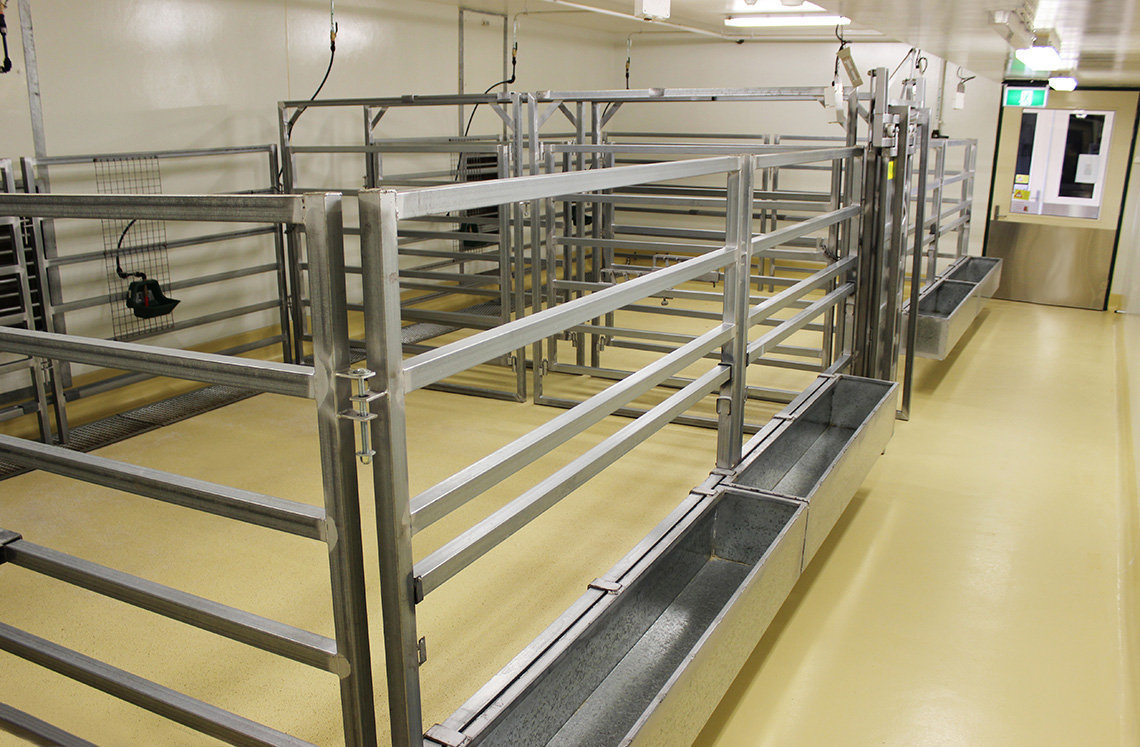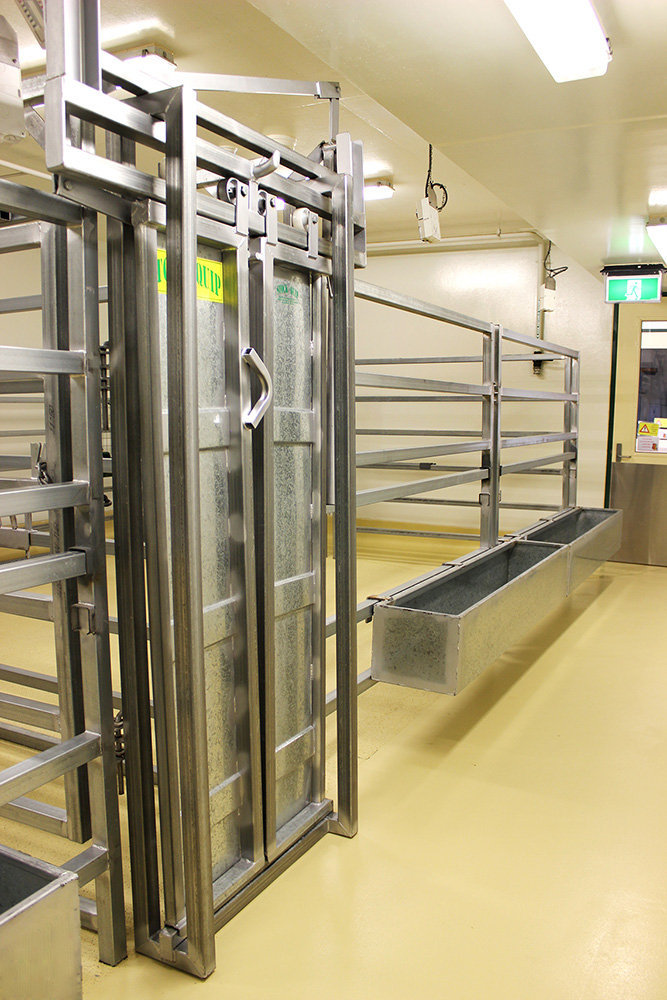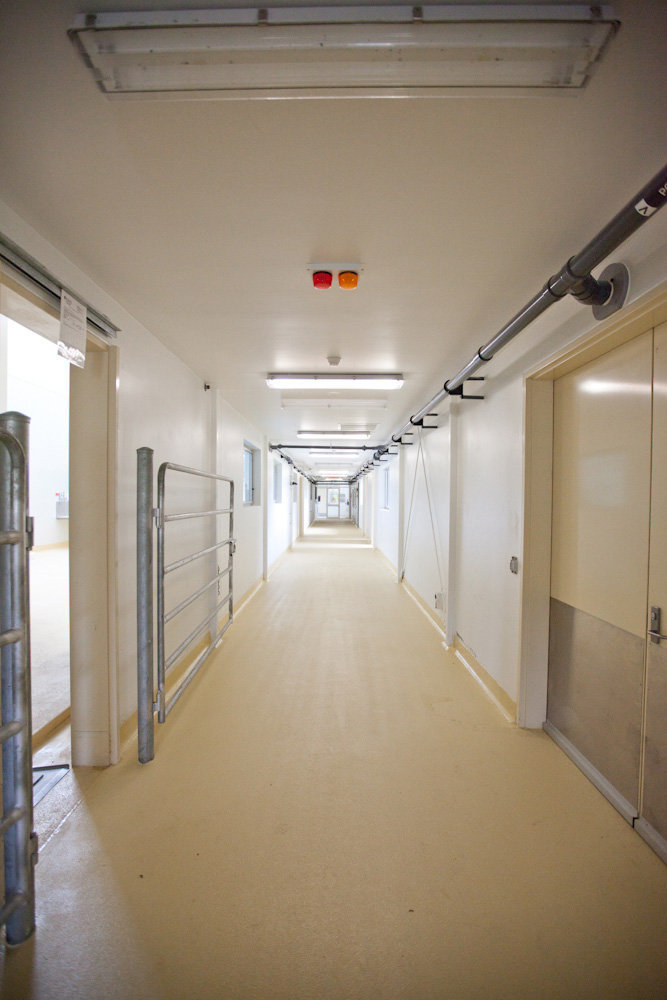PC2 certified animal study facilities
At a glance
- UQ IBC, OGTR and DAgWR certified
- 2 identical PC2 animal holding rooms (7m × 12m)
- 1 smaller PC2 animal holding room designed for smaller livestock (4-8)
- Ante rooms and showers
- Adjacent cull rooms and feed rooms
- Connected to PC2 corridor which links to a PC2 laboratory and necropsy room
- Smaller PC2 animal holding room directly linked to PC2 laboratory
- Fumigation ports
- Sophisticated waste treatment system
- Remote surveillance video cameras
Within the main building of the biocontainment facility there are two identical PC2 animal holding rooms each with ante rooms and showers on the external entry side and leading to the internal corridor. Both animal holding rooms measure 7m × 12m and are supported by a cull room. The Animal Holding Room (AHR) PC2 cull room is connected to the PC2 corridor which links to a PC2 laboratory and well equipped necropsy room. Each room also has fumigation ports facilitating easy fumigation between trials if needed.
The function of the PC2 containment level is the containment of risk group 2 (RG2) microorganisms within the facility and the prevention of infection of all who enter the facility. Specialised structural features include: negative air-flow and HEPA filtered air-conditioning; self-closing doors and sealed windows; smooth surfaces that are impermeable to water, cleanable and resistant to damage by cleaning agents; open spaces between and under benches and equipment such that they are easily accessible for decontamination. QASP staff also ensure specific behavioural requirements are followed by all entering PC2 areas including maintaining a heightened level of good laboratory practice and following procedures in accordance with regulated PC2 guidelines.
Adjacent to each of the ante rooms is a large feed room which opens directly to the outside and provides enough shelving space to store sufficient feed materials and other provisions for an entire trial. This reduces the passage of personnel into and out of the facility which is safer from an OHS, biosecurity, and biosafety perspective and is also preferable in terms of effective time management. QASP recognises the importance of research being undertaken in the timeliest manner without error, and will help facilitate solutions to achieve and support this.
In the anteroom there are magnehelic gauges mounted on the wall as a safety measure to ensure the knowledge that negative pressure is being maintained before entering the room.
Within the PC2 animal holding room all animal effluent waste is pumped via macerating pumps to the 4 Effluent Waste Treatment Plant Tanks. Each tank holds a total of 10,000 litres and the waste is treated using 19M sodium hydroxide. This is a state of the art waste treatment method tested and validated by a NATA registered laboratory. This novel system is the only one in the Southern hemisphere and is a cheaper method for the researcher than incineration or using the autoclaves. At QASP there is an additional decontamination or sterilising capability with back-up system two 500L steam sterilising autoclaves which are certified by SESS, the largest provider of hospital autoclaves nationally. These autoclaves can also be used to sterilise equipment used in the PC2 facility.
The PC2 AHR facility is fully temperature and light controlled, with all exhaust air HEPA filtered as facilitated by the Building Management System (BMS) controlled by QASP staff with contractor Johnson Controls complementing operations 24 hours a day, 7 days a week, to ensure any issues can be rectified before any impact on research. Alarms will be set off automatically if any set parameters approximate a breach of required conditions. QASP staff are on call at all hours and the alarms trigger remote notifications such that any issues will be rectified immediately to minimise any impacts to research.
The animal holding rooms are empty as is standard QASP practice to allow experiments to be custom designed in line with specific trial needs. Full pen setups can be hired and installed by QASP.
QASP staff are well trained in the requirements of PC2 research and can be involved in research trials at a level determined by QASP Management and the Chief Investigator. Systematic daily checklists have been developed by QASP staff to ensure a number of parameters and controls are in place prior to the entry of any personnel into the facility to ensure the safety of the researchers. QASP staff are experienced in bleeding, taking samples and performing other specialised animal research techniques which allows research procedure to be undertaken if required.

Remote surveillance video cameras are installed and could be utilised in the future to allow remote observation of animals without frequent entry to the facility.
Prior to being housed in the PC2 animal holding rooms, animals are habituated to a pelletised diet in preference to hay and lucerne which cannot pass through the pumps to be decontaminated at the Effluent Waste Treatment Plant. Animals are also conditioned to QASP staff walking past them several times a day wearing full PPE and making noises and simulating daily processes and research activities. The habituation phase that usually lasts at least a week is also used by QASP staff to assess individual animal temperaments which can assist with experimental design considerations.


